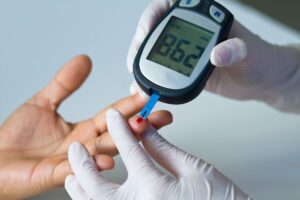What is Diabetes?
Diabetes is a chronic (long-lasting) health condition that affects how your body turns food into energy.
Your body breaks down most of the food you eat into sugar (glucose) and releases it into your bloodstream. When your blood sugar goes up, it signals your pancreas to release insulin. Insulin acts like a key to let the blood sugar into your body’s cells for use as energy.
- Diabetes by the Numbers
- About 38 million US adults have diabetes, and 1 in 5 of them don’t know they have it.
- Diabetes is the eighth leading cause of death in the United States.
- Diabetes is the No. 1 cause of kidney failure, lower-limb amputations, and adult blindness.
- In the last 20 years, the number of adults diagnosed with diabetes has more than doubled.
According to Research:
- The number of people with diabetes rose from 108 million in 1980 to 422 million in 2014.
- Prevalence has been rising more rapidly in low- and middle-income countries than in high-income countries.
- Diabetes is a major cause of blindness, kidney failure, heart attacks, stroke, and lower limb amputation.
- Between 2000 and 2019, there was a 3% increase in diabetes mortality rates by age.
In 2019, diabetes and kidney disease due to diabetes caused an estimated 2 million deaths.
- A healthy diet, regular physical activity, maintaining a normal body weight and avoiding tobacco use are ways to prevent or delay the onset of type 2 diabetes.
- Diabetes can be treated, and its consequences avoided or delayed with diet, physical activity, medication and regular screening and treatment for complications.
Types of Diabetes
There are three main types of diabetes: type1, type2, and gestational diabetes (diabetes while pregnant).
Type 1 Diabetes
Type 1 diabetes is thought to be caused by an autoimmune reaction (the body attacks itself by mistake). This reaction stops your body from making insulin. Approximately 5-10% of the people who have diabetes have type 1. Type 1 diabetes can be diagnosed at any age, and symptoms often develop quickly. If you have type 1 diabetes, you’ll need to take insulin every day to survive. Currently, no one knows how to prevent type 1 diabetes.
Type 2 Diabetes
With type 2 diabetes, your body doesn’t use insulin well and can’t keep blood sugar at normal levels. About 90-95% of people with diabetes have type 2. It develops over many years and is usually diagnosed in adults (but more and more in children, teens, and young adults). You may not notice any symptoms, so it’s important to get your blood sugar tested if you’re at risk. Type 2 diabetes can be prevented or delayed with healthy lifestyle changes, such as:
- Losing weight.
- Eating healthy food.
- Being active.
Gestational Diabetes
Gestational diabetes develops in pregnant women who have never had diabetes. If you have gestational diabetes, your baby could be at higher risk for health problems. Gestational diabetes usually goes away after your baby is born. However, it increases your risk for type 2 diabetes later in life. Your baby is more likely to have obesity as a child or teen and develop type 2 diabetes later in life.
THINGS TO AVOID AS A DIABETIC PATIENT
FOOD
It may take a while to find the right eating pattern for you, but a good place to start is to ask your diabetes doctor about the following diets. Studies show these diets can help people with diabetes reach their blood sugar, heart health, and weight loss goals. No matter which diet appeals to you, talk to your doctor before you make a switch in your diet. No matter what you eat, you still need to track it and understand how it affects your insulin levels. It may take a while to find the right eating pattern for you, but a good place to start is to ask your diabetes doctor about the following diets. Studies show these diets can help people with diabetes reach their blood sugar, heart health, and weight loss goals. No matter which diet appeals to you, talk to your doctor before you make a switch in your diet. No matter what you eat, you still need to track it and understand how it affects your insulin levels.
SMOKING
Avoid smoking or quit smoking if you smoke. Smoking increases your risk of type 2 diabetes and the risk of various diabetes complications, including:
- Reduced blood flow in the legs and feet, which can lead to infections, nonhealing ulcers and possible amputation.
- Worse blood sugar control
- Heart disease
- Stroke
- Eye disease, which can lead to blindness.
- Nerve damage
- Kidney disease
- Premature death
Talk to your health care provider about ways to help you stop smoking or using other types of tobacco.
INJURIES
Avoid injuries minor or major as it might take time to heal or get infected, most especially the feet.
High blood sugar can reduce blood flow and damage the nerves in your feet. Left untreated, cuts and blisters can lead to serious infections. Diabetes can lead to pain, tingling or loss of sensation in your feet.
To prevent foot problems:
- Wash your feet daily in lukewarm water. Avoid soaking your feet, as this can lead to dry skin.
- Dry your feet gently, especially between the toes.
- Moisturize your feet and ankles with lotion or petroleum jelly. Do not put oils or creams between your toes — the extra moisture can lead to infection.
- Check your feet daily for calluses, blisters, sores, redness or swelling.
- Consult your doctor if you have a sore or other foot problem that doesn’t start to heal within a few days. If you have a foot ulcer — an open sore — see your doctor right away.
- Don’t go barefoot, indoors, or outdoors.
STRESS
If you’re stressed, it’s easy to neglect your usual diabetes care routine. To manage your stress, set limits. Prioritize your tasks. Learn relaxation techniques.
Get plenty of sleep. And above all, stay positive. Diabetes care is within your control. If you’re willing to do your part, diabetes won’t stand in the way of an active, healthy life.
You may like to read: the most ignored cancer symptoms.



